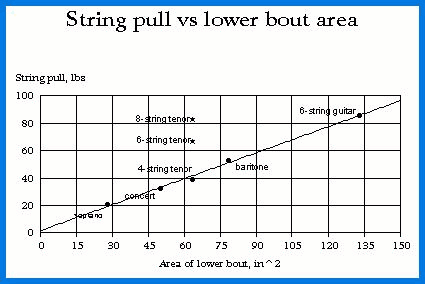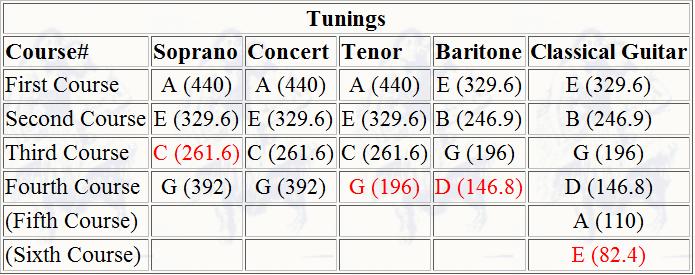Strings
The third table in the Sounds section is repeated for convenience in order to make a few points about stringing ukuleles. There are four courses of strings on an ukulele; each course may have as few as 1 or as many as 3 strings in it. Typically soprano and baritone ukuleles have a total of four strings. Concert ukuleles may have the C course as an octave pair, with the second C string being higher; they may also be strung with the G note an octave lower. Tenors are the most variable in their stringing with the following combinations being most common: In Hawaii, the 4-string tenor ukulele is normally strung with the G set at 196 Hz, that is a “low” G. It is also possible to string the 4-string tenor DGBE, similar to the first four strings of the guitar, except that the D note is higher than the G in this case. This is an interesting tuning in that the air resonance of the tenor is still readily available for exciting because of the presence of the low G on the third string. 6-string tenor ukuleles are generally strung with the G at 392 Hz, an octave pair of C strings, the E at 329.6 Hz, and an octave pair of A strings with the lower A at 220 Hz. It is also possible to have the G set at 196 Hz, but then the A strings are both at 440 Hz in order to still access the air resonance. The 8-string is nearly always set with an octave pair of G strings, an octave pair of C strings, both E strings at 329.6 and both A strings at 440 Hz. Tiple stringing will not be discussed.
Finding quality strings is a persistent problem. Although there are probably a number of acceptable combinations, we are currently using D’Addario custom-made bass strings for the G & A strings on tenors and the D and G strings on our baritones. Savarez Alliance blue and reds in the trebles are suitable for concert through baritone sizes. We do not offer these strings as blanket recommendations but rather note that they work for our bracing and construction approach.
As a general information service we have calculated the approximate cumulative tension in lbs for each size ukulele as well as the guitar and for the various number of strings associated with different models.
For reader convenience we also include a graph of cumulative string tension vs. lower bout area for various sized ukuleles. Note that the 6- and 8-string tenors fall above the line and therefore require additional bracing in order to maintain top integrity. Builders beware…;)
String Tension vs Lower Bout area 
If you enjoy the technical side of things, please consider buying my book “Left-brain Lutherie” . Although no longer sold by StewMac, you can buy directly from me.
I enjoy writing these pages and hope that they are interesting and useful to the reader. I’ve stopped building at this time and still need to generate some income in order to continue to expand this website with more useful articles. If this page was helpful to you and you would like to make a $5.00 donation in order to have more pages like it, please use the donation button below. Thank you.

